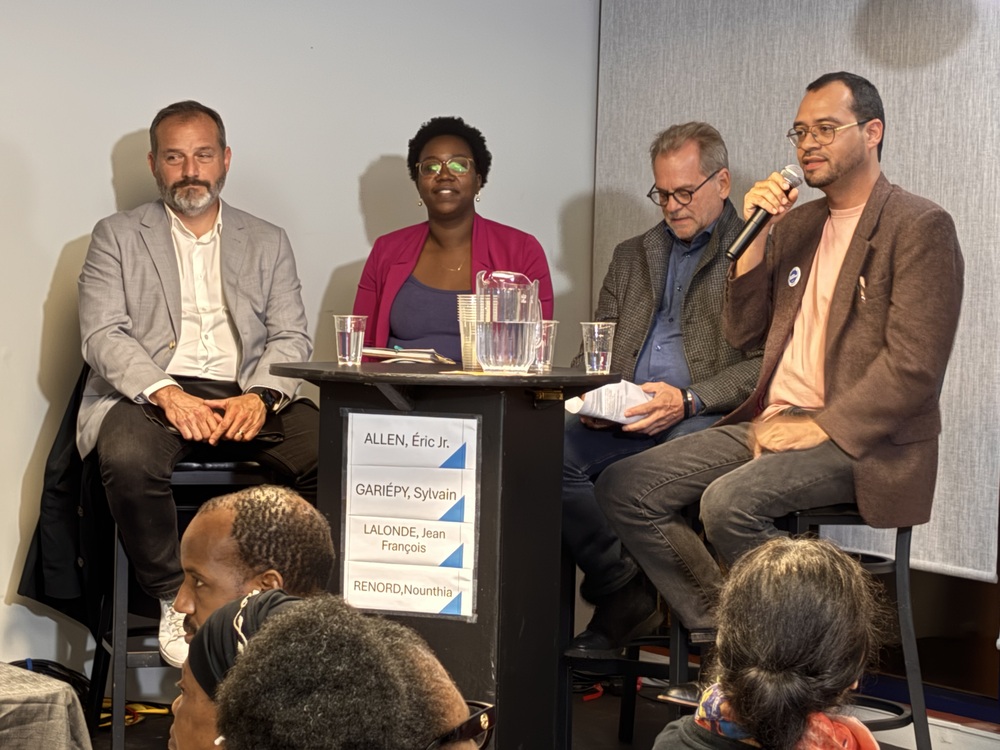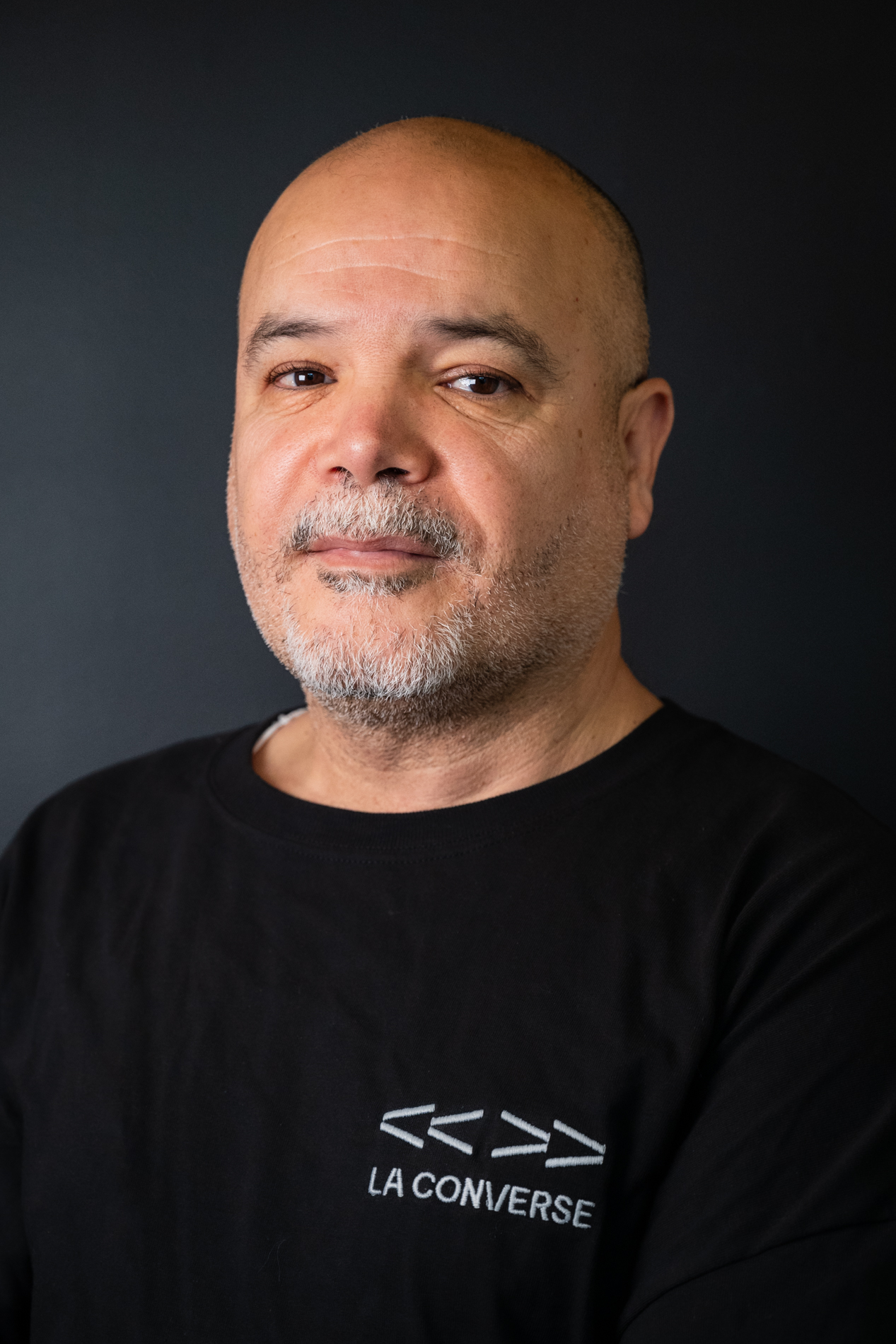Friday, October 24. Suite 100 of the Carrefour populaire de Saint-Michel is overflowing. Tables are set, chairs are close together, whispers of anticipation fill the room, and the soup is still heating in the kitchen. It’s 5:15 p.m. The young coordinators of the neighborhood table, Vivre Saint-Michel en santé (VSMS), exchange quietly, reviewing the evening’s schedule.
Half an hour later, when Aya Boucenna, a journalist with La Converse and member of the Saint-Michel Youth Forum, and Wismy Noster from VSMS take the microphone to open the event, the room is packed. In front of them, residents of Saint-Michel from all backgrounds have come to discuss municipal politics—a topic that often struggles to mobilize people here.
Indeed, in this East Montreal neighborhood, where, according to Elections Canada, fewer than one in four voters showed up for the 2021 municipal elections, such a gathering is no small event.
A neighborhood apart
Fragmented and enclosed by Highway 40 and the Francon and Miron quarries, Saint-Michel is one of the most densely populated and multicultural areas of Montreal.
A 2024 portrait conducted by VSMS for the neighborhood’s 2025–2029 strategic planning shows that nearly 70% of residents are immigrants and that more than 60 languages are spoken. It is also one of the youngest districts—one in three residents is under 25—and one of the most precarious, with a median income 30% below the Montreal average.
The neighborhood has long been an arrival point for newcomers: Haitians, North Africans, Filipinos, Tamils, and Bengalis. But for many, Saint-Michel is only a temporary stop. According to Christian Toussaint, a VSMS community liaison, “It’s a transient neighborhood where people arrive, settle for a few years, and leave as soon as they can.” This constant movement, he adds, “makes mobilization difficult,” requiring “a continuous effort to raise awareness—it’s a perpetual battle.”
The challenge of participation
This evening is the last in a series of four events aimed at reviving civic engagement—a bold challenge in a neighborhood with one of the lowest voter turnouts in Montreal. In 2021, only 24.3% of registered voters in Saint-Michel cast a ballot.
Mohamed Mimoun, director of the Saint-Michel Youth Forum, points out that “in a district with a high rate of immigration, there isn’t a strong voting culture.” Speaking on the sidelines, he notes that “some people don’t even know there are municipal elections” and that “they aren’t prepared to exercise their right to vote.” For him, “people don’t see how their vote can make a difference. And sometimes, they can’t even tell the candidates apart.”
Similarly, Christian Toussaint, VSMS community liaison responsible for culture, sport, and leisure, highlights a democratic transmission problem: “Many come from countries where they didn’t have the right to vote. Some are afraid, others don’t understand the system. That’s why education is needed constantly.”
But migration alone doesn’t explain the low municipal turnout. To go further, VSMS has organized a series of activities in recent weeks—election cafés, informational meetings, public debates—to try to reconnect residents with institutions.
This dinner-discussion aimed to show residents that municipal politics also belongs to them. Ultimately, it provided participants with a space to explain why so many have felt distanced from it.
Exchanges rooted in daily life
An improvised stage in the corner of the room was reserved for the four candidates running in the Saint-Michel district for the Villeray–Saint-Michel–Parc-Extension borough council.

Éric Allen Jr. (Action Montréal), Sylvain Gariépy (Ensemble Montréal), Jean-François Lalonde (Projet Montréal), and Nounthia Renord (Futur Montréal) came to engage with residents. Debate topics included housing access, local economic development, social development, mobility, security, youth, and neighborhood connectivity.
The microphone circulates among the audience. “Hello, my name is Samir Souanes, I’m 21. I’d like to ask a question about homelessness. I’ve noticed that rates have increased recently,” says a young man. The panelists take turns responding with their party’s vision—more social housing, as Lalonde proposes; more resources for organizations tackling homelessness, as Gariépy and Renord suggest; or even specialized programs for these populations, as Allen recommends.
Meanwhile, a hot meal is served: fragrant rice, grilled chicken, and salad. “A real feast,” one resident whispers.
In the room, the average age exceeds 40. Apart from a few Youth Forum members, young people are largely absent. Their absence does not go unnoticed. Several speakers emphasize the need to find new ways to engage them in these issues.
“What’s the point of voting if they won’t listen?”
Among the few young attendees, 25-year-old Mark Dagala shares his feelings.
“Yes, I’ll vote, even though the results might be a little… perhaps skewed,” he says, searching for words: “Even when we talk about our needs, they’re ignored in a way.”
His friends don’t vote. “They say, ‘What’s the point of voting if they won’t really listen to us?’” He points to the lack of consultation on local decisions, notably the bike lane project in summer 2022: “When we saw the bike lane on Première Avenue, no one consulted us. People felt abandoned.”
Consultation was a key topic at the meeting, and candidates discussed the municipal council’s dysfunctional citizen consultation system. Gariépy and Allen also referenced the Première Avenue bike lane project.
Mark Dagala adds, “I feel completely abandoned. Funding was relocated to neighborhoods with higher returns, like Villeray or the Plateau. We were an afterthought.”
Another young resident, Ahmed El Moudden, a former journalist at L’École Converse and a decade-long participant in the Youth Forum, echoes his peer. “Ten years ago, young people were very engaged. They gathered and discussed political issues. Today, they have less faith in Saint-Michel and politics in general,” he says to the attentive audience.
Around the tables, many nod. Ahmed attributes this disengagement to unfulfilled promises: “Many causes that young people pushed over the past 10 years have not really materialized.” He cites the Francon quarry—a vast stone pit in the heart of the neighborhood, still undeveloped: “We invested a lot of effort there. Very little progress was made. The City abandoned young people,” he laments.
The Francon quarry, roughly the size of 98 soccer fields, comes up multiple times. Since its closure in 1986, the quarry, owned by the City since 1981, has been used as a municipal warehouse and mostly as a snow dump. Residents request the site’s redevelopment, and public consultations have taken place, including by the Montreal Public Consultation Office (OCPM) in 2008 and a participation process launched in 2016. VSMS created the citizen project Francon, Heart of Our Neighborhood in 2018, but no political decision has realized the community’s dream.
Many voices, same fatigue
The sense of abandonment recurs throughout the testimonies.
Sugir Selliah, a resident of East Saint-Michel, describes a neighborhood losing services. “Not only is Saint-Michel the most disadvantaged of the three borough neighborhoods, but the East sector is even more so,” she laments. She notes a “dire lack of green spaces,” “disengaged youth,” and “loss of numerous services,” evidenced by the departure of community organizations after the school board took over their premises.
She also highlights the gap between elected officials and residents: “Residents feel less heard because proposed needs are misaligned. Officials must go to the citizens, go door-to-door, present themselves in person.”
Throughout the exchanges, residents demonstrate insight into neighborhood issues and a desire to be heard. Between interventions, the clatter of cutlery and soft laughter of volunteers can be heard. Wismy Noster, in charge of community liaison at VSMS, observes the discussions: “Each table, each question represents progress. For the first time in five years, we’ve managed to mobilize so many people,” he notes.
Yet he remains realistic: “Mobilization is never easy, especially in a neighborhood like Saint-Michel. Many people juggle multiple jobs. When you invite them to civic activities, the response is often: ‘Sir, I need to keep the pot boiling.’” Daily life constraints partly explain the low turnout, he says: “It’s not disinterest, it’s fatigue.”
An evening, then calm
By 9 p.m., the room slowly empties. Chairs are folded, microphones unplugged. Outside, the streets of Saint-Michel fall silent. Only the Petit Maghreb cafés remain lively, and a few workers wait for the bus on Pie-IX. In this neighborhood, where voting is never automatic, life returns to its usual rhythm.





%20(1).jpg)
.jpg)
.jpg)